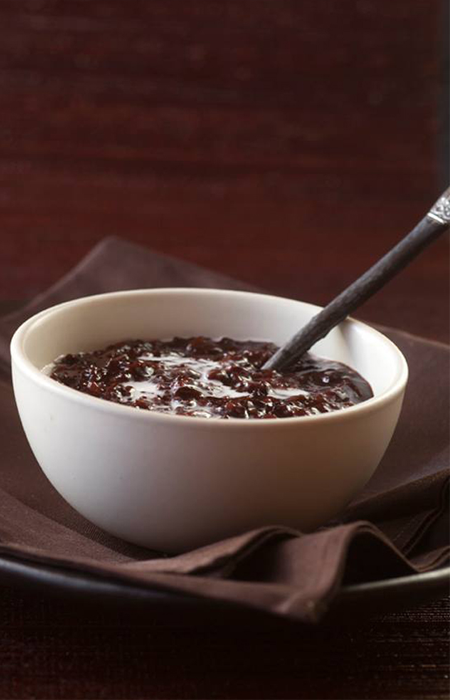Most people who taste black sticky rice for the first time find it exceptionally delicious. Gluten-free and high in fiber and antioxidants, this unmilled rice actually appears a deep burgundy color when cooked. You’ll need to plan a day ahead to make this traditional recipe because glutinous rice needs to be soaked a minimum of six hours or preferably overnight.
Serves 6
1 cup black glutinous rice, soaked in 2 cups of water overnight
1/3 cup plus 3 tablespoon sugar
2 tablespoons rice flour or cornstarch mixed with 2 tablespoons water
1½ cup or 1 (14 fl ounce) can coconut milk
1 teaspoon salt
1. Wash the rice by gently rubbing the grains with your fingers in a bowl of water until the water runs clear. Drain the rice and place in a medium bowl with 2 cups of water. Allow the rice to soak overnight.
2. When ready to cook, drain the rice and place it in a pan with 4 cups water. Bring to boil over high heat. Reduce the heat to medium-low and simmer the rice for 30 to 40 minutes, stirring intermittently to prevent the rice from burning and sticking. Add the remaining 2 more cups
of water and 1/3 cup of the sugar, and cook for 10 minutes. As the rice cooks, it will crack open, become thicker and appear burgundy in color.
3. Meanwhile, combine coconut milk, sugar, salt, and cornstarch in a medium saucepan over medium-low heat. Stir constantly to dissolve the sugar and to thicken the sauce. When the sauce begins to coat the ladle, about 5 minutes remove it from the heat.
4. Pour ½ cup of the coconut sauce into the black sticky rice and mix well. Pour the remainder into a bowl and reserve for serving.
To serve, spoon the warm sticky rice in individual bowls, and top with the coconut sauce. Serve warm.

